By the end of 2025, 26% of the world’s population will be Gen Z. If you have a business and you don’t know much about Generation Z and how to market to Gen Z, it’s time you should learn about them.
Because the global demographics are changing rapidly and your primary target audience might switch to Gen Z (very soon).
What’s important is that marketing to Gen Z is quite different from marketing to older generations.
How is that different and what can you do about it?
Let’s find out in this detailed guide.
What is Gen Z?
Gen Z, or Generation Z, or Zoomers, refers to people born roughly between 1997 and 2012. This is the generation that precedes Generation Alpha and succeeds Millennials.

It is the first generation that opened its eyes in the digital world, where the internet was used extensively. This shaped their behavior and perspective, which is reflected in how they spend time online and offline.
Their lives are shaped by the internet and digital revolution, and they are often known as digital natives.
Gen Z Characteristics
When you have to market to Gen Z, you need to understand them as much as you can. This goes for any type of business and its target audience.
The primary values and characteristics that make Generation Z unique are stated below:

Tech-Savvy
Generation Z is a tech-savvy generation as it has grown in the digital era. These are the people who haven’t seen conventional televisions, VCRs, and stuff from the 90s (and before).
The digital world moves at a very fast pace with new advancements. This has made Gen Z prone to quickly adapting to new tech, and they are natural learners and adopters.
Research shows that 66% of zoomers used WordPress to create a website, 52% of Gen Z want to use virtual reality, and 43% say that smart devices are essential for households these days:

It’s a digitally literate generation that moves with the tech trends.
Flexibility and Transparency in the Workplace
Several studies and surveys reported that Generation Z is an advocate of flexibility and transparency at work.
A survey by Indeed reported that 54% of Zoomers won’t accept a job offer that doesn’t offer flexible work hours, and 85% are of the view that pay should be a part of the job post:

Another study by Deloitte found that flexibility is the most important factor for Gen Z when choosing a job. Around 75% of Zoomers say that they’ll prefer a job with flexibility over high pay.
As this generation is becoming part of the workplace and would account for up to 30% of the workforce in the US by 2030, it’s important for businesses to understand their needs as they’ll be hiring them sooner.
More Diverse
Gen Z is more diverse than other generations.
According to Pew, one in four Zoomers is Hispanic and one in two is white. This gap has reduced significantly in Gen Z as compared to millennials:

A common reason for this is an increase in the number of children in immigrant families, which increased from 19% of the total population of the US in the 2000s to 25% in 2021.
This diversity plays a crucial role in marketing to Gen Z across all levels.
Educated from an Educated Family
The same study by Pew also reported that Gen Z is more likely to be enrolled in college, and they are more likely to have an educated parent than older generations:

Since Millennials is the most educated generation prior to Gen Z, and most Zoomers are kids of Millennials, this makes their parents well-educated.
As a high percentage of Gen Zers pursue a college degree, they usually don’t work when they are teens. This has multiple consequences for businesses and marketers:
- Zoomers depend on loans for education
- They are more likely to enter the job market with little to no work experience
- High salary expectations.
How do you use this in marketing and business? It all depends on you.
Reaching Life Milestones
In 2025, Gen Zers are achieving major goals in their lives as they have reached 28 years in 2025.
Life milestones include:
- Marriage
- Kids
- Job
- Decision-making in the workplace
- Spenders
- Homeowners.
A study reported that the percentage of Gen Zs who are married increased to 45% in 2025, and a 23% increase in Zoomers who have kids. An additional 19% of Gen Zers are decision-makers at their workplace now.
Another survey found that the number one goal of Gen Zers is to make money, followed by having a successful career, time for hobbies, and having a family:

These major life changes can be used in marketing to connect with the right people at the right time.
Social Media Users
As much as 97% of all Zoomers learn about new products from social media. This is something that you don’t find with previous generations.
It’s also important to understand Gen Z behavior and patterns of using social media. The key statistics are discussed below:
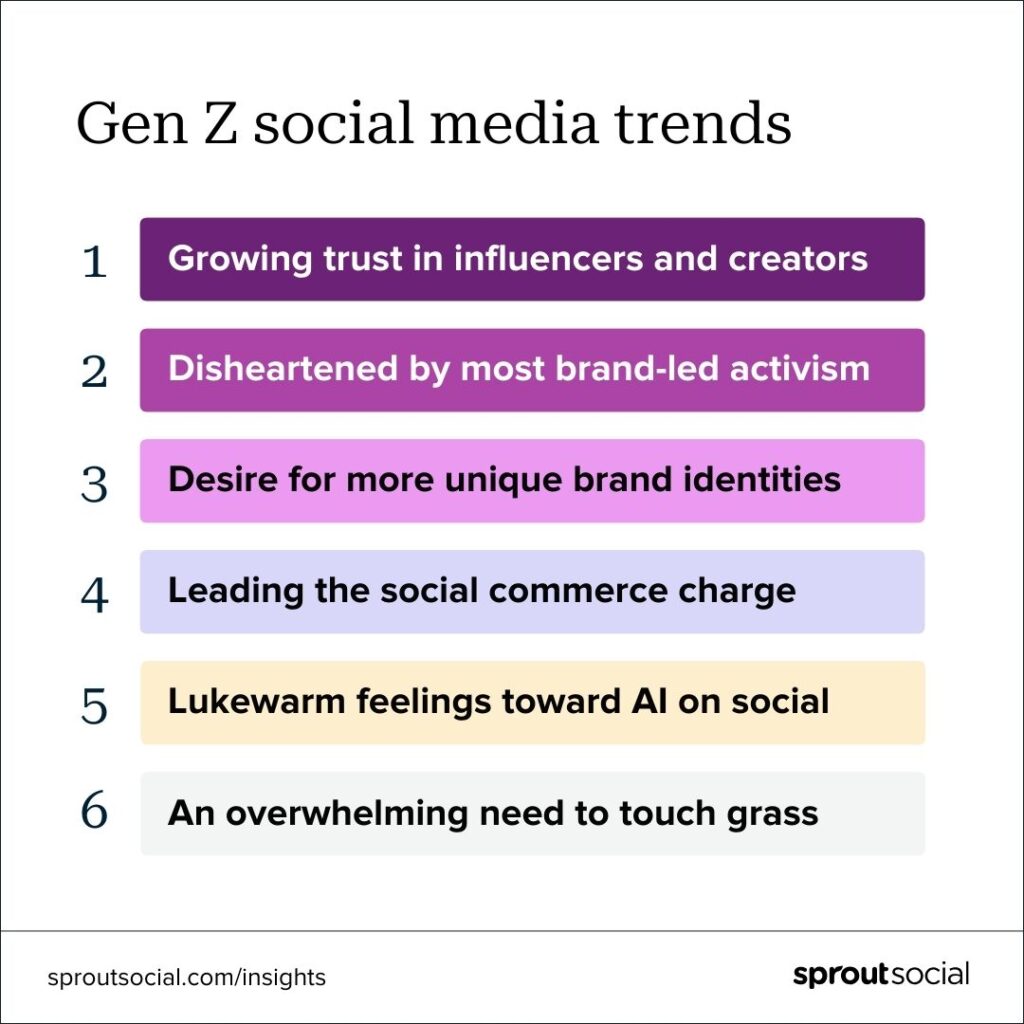
- Follow influencers and content creators (56%), meme accounts (50%), and people who share their interests (49%)
- Most used social platforms: YouTube (78%), Instagram (76%), TikTok (69%), and Snapchat (43%)
- Use TikTok for product discovery and news
- Prefer using Instagram for customer care
- 73% use TikTok as a primary search engine
- Type of content they consume: Gaming videos (51%), comedy and memes (49%), and live video stream (38%)
- Spend up to 3 hours per day on social media
- 43% use social media daily to get news updates from their favorite brands and influencers.
Investment Mindset
Gen Zers are into saving and investing.
A recent survey by the World Economic Forum reported that 30% of Zoomers start investing in their early adulthood, and when they enter the workforce, 86% of them understand the importance of personal investing.
Another study reported that Gen Z starts investing at age 19 and up to 45% of Zoomers had invested some amount at the time of the survey:

It’s not just about investing, Gen Z is saving more than any other older generation.
On average, Gen Z is reported to save 36% of their salary, which is a lot compared to older generations:
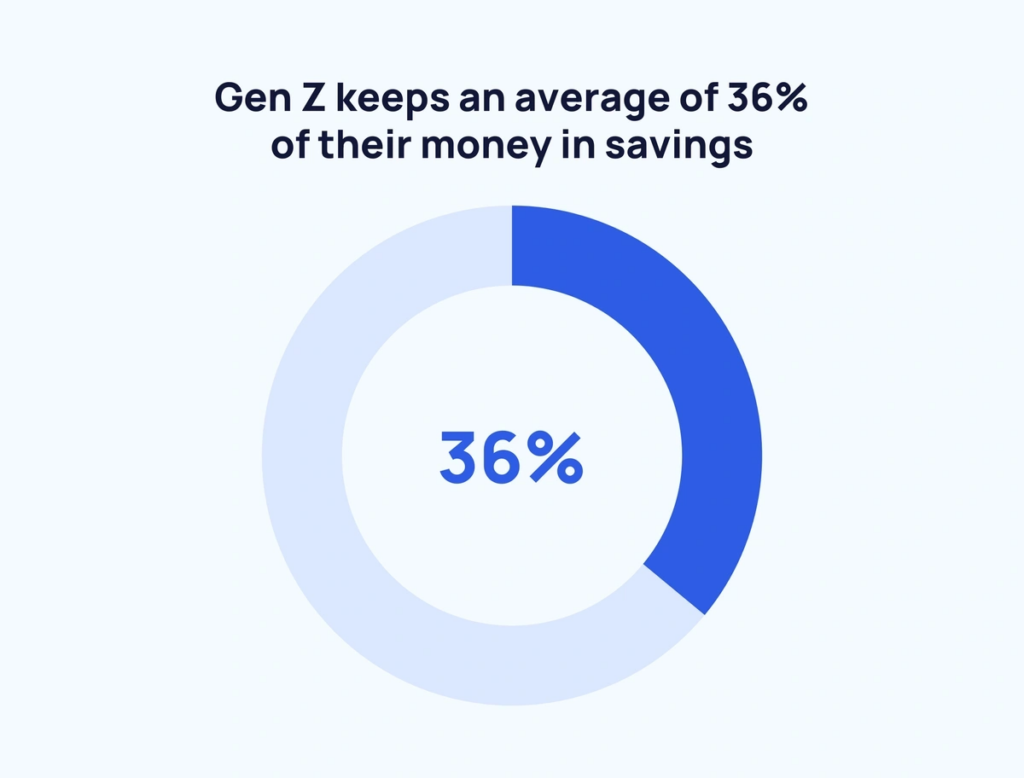
Around 21% of Zoomers save between 1-10% of their salary per month, 25% save 11-25% per month, 21% save 21-30%, and 5% save their full salary.
High Stress
With all the positives, Gen Z seems to be on the higher side of stress and anxiety.
A survey reported that Gen Zers report the lowest on mental health scores across all generations. The same goes for news events that have a high impact on Zoomers:

Not surprisingly enough, they are the most stressed workers in the workplace. Workers between 18 and 24 reported having 91% stress compared to others, who reported 84%.
They have usually:
- High anxiety
- Low productivity
- Low mental health
- High burnout
- Depression.
How to Market to Gen Z Effectively
Based on their unique characteristics as discussed above, you need to market to Gen Z differently via marketing strategies and techniques that align with their goals and behavior.
Let’s explore the best ways, techniques, approaches, and practices to market to Generation Z:
Use Social Media
Gen Z is all into social media. It’s the generation that uses social media extensively on a daily basis, and they use it not just for socializing, but to follow brands and for online shopping.
Research shows that 95% of Zoomers use social media daily, and 54% of them find it very hard to stop using social media. Up to 83% of Gen Zers shop on social media actively:

The best way for marketers to market to Gen Z is via social media. You need to connect with them organically and through social ads.
If you look at the types of social media platforms most Zoomers use, you’ll notice that most of them use video platforms like YouTube, TikTok, and Instagram. As much as 61% of Gen Zers prefer short videos under 1 minute. It shows they are more into short videos like Reels, and the reason why TikTok is so popular among teens.
Generally, Gen Z spends time across all types of social media platforms including Pinterest, Snapchat, Facebook, and BeReal:
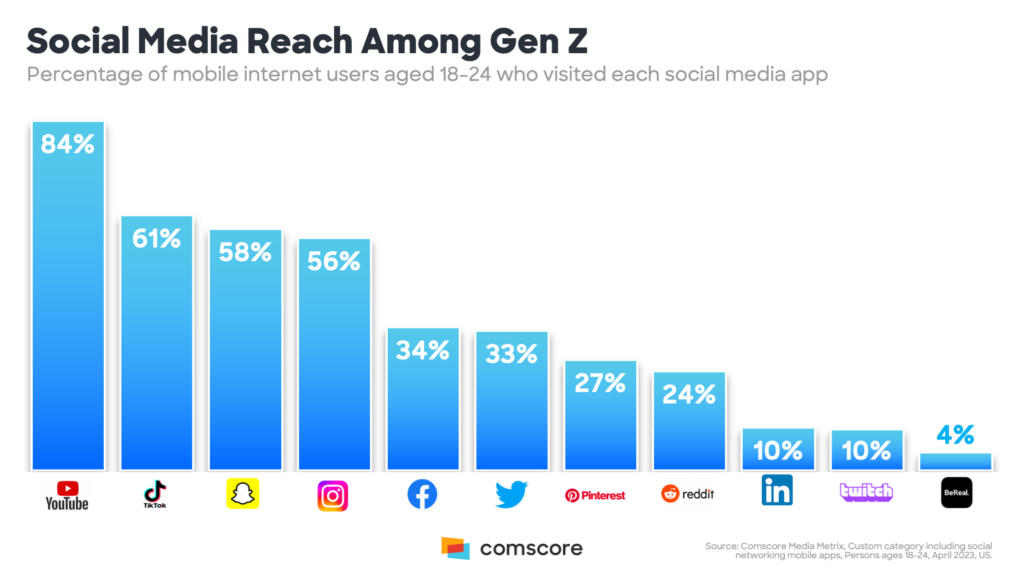
The way you connect and engage with Gen Z on one of these social platforms is more important than anything else. You can’t just hook them with any content rather, you need to look at the type of content they prefer.
Follow these best practices and tips to market to Gen Z on social media sites:
- Be authentic and transparent as this is what Zoomers appreciate
- Work with influencers in your niche. Gen Zers prefer following real people they trust
- Avoid spending too much on social ads as they don’t like too much of ads
- Focus on experience rather than product features
- Highlight your brand values and philosophy so your target audience can get to know your business more
- Spend more time building a community where your social accounts are powered by user-generated content
- Use video content as much as you can.
Leverage Video Marketing
Video content is the preferred content type of the majority of Gen Zers.
The top 3 video content types Gen Z prefer include social videos and live stream, TV shows, and movies:

The majority of Zoomers (up to 61%) prefer short videos under 60 seconds. This is because they have grown up in an era of TikTok and Reels. They are used to seeing short videos, and that’s what they like the most.
They don’t like text and images as much as they are into video content.
This is where you need to spend resources.
Zoomers like seeing specific types of videos from brands they follow:
- How-to videos
- Customer testimonial
- Funny videos.

Marketing to Gen Z should be focused on video content. You need to rely heavily on two types of videos when targeting Zoomers:
- Real, step-by-step branded videos that show the actual product. In this case, showcase how to use the product or explain its key features specifically
- Use customer testimonials in marketing campaigns to reach out to Gen Zers. Incentivize your existing customers for creating and sharing real-life videos of your product. This should also include influencer marketing.
Use Influencer Marketing
Gen Z trusts recommendations from influencers and people they know. They don’t take ads and branded content too seriously. This is a reason why influencer marketing turns out to be one of the best ways to market to Gen Z.
As much as 40% of Gen Z say that they trust influencers more than their friends. Around 57% of Zoomers will buy a product recommended by an influencer as opposed to 40% who’ll buy based on a recommendation from a friend.
The two major reasons, according to Fortune, why Gen Zers have stopped trusting friends and experts and trust influencers more are:
- Influencers are more convenient in terms of storytelling and are more authentic
- Influencers feel like friends and are trustworthy.
Other reasons include:
- Relatability
- Personalized recommendation
- Detailed, long-form video content with practical knowledge
- Influencers introduce them to new, useful products.
Influencer marketing should be a part of your marketing strategy if you are marketing to Gen Z. We have a detailed influencer marketing checklist that you should check out.
Follow these guidelines and best practices when setting up and running an influencer marketing campaign to market to Gen Z:
- Collaborate with influencers who your primary target audience already follows and trusts. Gen Z doesn’t trust just any random expert or influencer rather, they are very particular about who they follow and trust.
- The content should be top-notch and very detailed. If it’s a long-form video, it should discuss the practical aspects and uses of the product. For short-form videos, it must connect emotionally and should grab their attention.
- Look for micro and nano influencers with higher engagement than macro influencers. Gen Zers prefer engagement, personalization, and connection. They are more likely to trust the recommendations of nano or micro-influencers than a popular celebrity.
- Collaborate with multiple influencers instead of spending money with one or two.
Be Socially Responsible
Is your business socially responsible? Do you give back to the community in some way? Do you advertise and communicate how your business is making a positive impact on the society and environment?
You should…
Because that’s one of the best ways to market to Gen Z.
Studies show that Gen Z is the generation that wants companies to be socially responsible. When accepting a job offer or buying from a brand, Gen Zers look at the company’s social responsibility initiatives and then make a decision.
According to a survey, 24% of Zoomers look at the social impact of a company when accepting a job offer:

More than 87% of Zoomers believe that businesses have the responsibility to address environmental and social challenges:

They follow the same pattern and behavior when buying from a brand.
Up to 51% of Gen Zers choose to buy from brands that are eco-friendly, and 49% from brands that use natural ingredients. As much as 74% of Zoomers will boycott brands if they go against their personal values. More than 64% of Gen Zers will pay more for products from sustainable and socially responsible businesses:
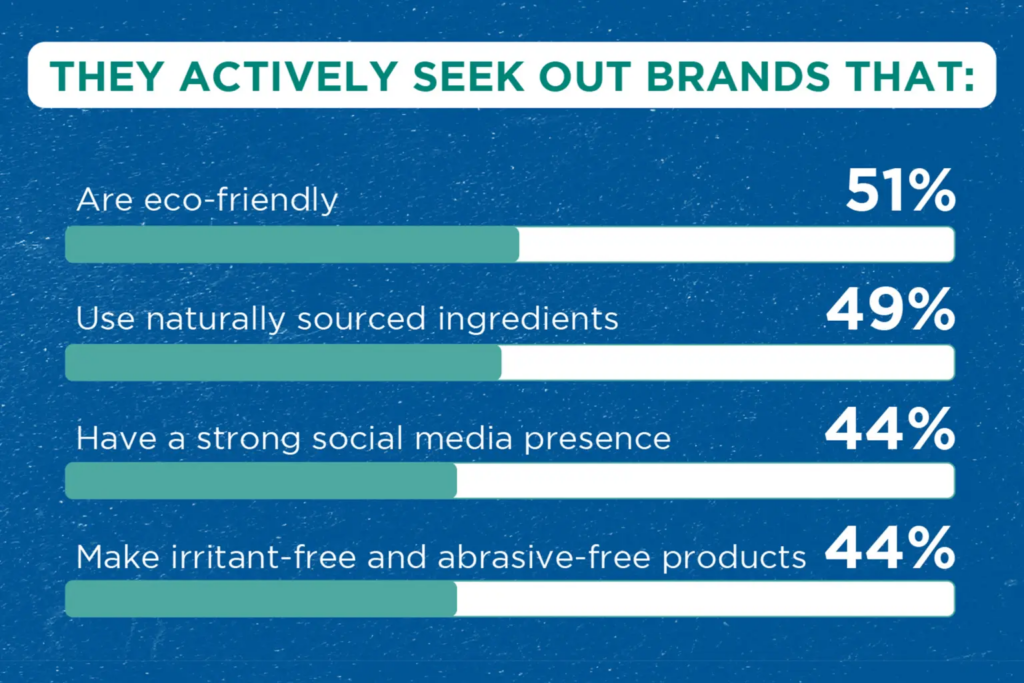
You need to contribute to the environment as a business if you want to market to Gen Z and want them to stick with your brand. This includes a lot of different aspects including:
- Eco-friendly products and business processes
- Corporate social responsibility
- Climate-friendly business practices
- Natural and organic ingredients.
Follow these practices to make your business socially responsible and attractive to Gen Z:
- Have a socially responsible organizational culture and practices
- Market your business’s environment-friendly practices
- Reduce carbon footprint
- Use natural products and ingredients in the manufacturing process
- Spend on community development in the form of charities and donations
- Use sustainable materials for packaging and manufacturing
- Measure and report the positive impact your business has on the environment and society
- Market your green practices to your target audience without hype
- Make it all traceable and transparent so anyone can verify your claims.
Offer Incentives and Discounts
Gen Z is known as the coupon generation. They love discounts and sales.
A study reported that 60% of Gen Zers find free shipping as the most appealing offer, followed by 52% who consider free gifts as most valuable, and then 47% find a 20% occasional discount as appealing:

Eight out of ten Zoomers say that a discount between 15-20% is what persuades them to shop clothes online, followed by free delivery as the second most appealing offer.
A survey found that up to 45.3% of consumers including Gen Z are most interested in receiving personalized discounts and promotions from brands:

Discounts coupled with personalized recommendations are an ideal duo.
Random, untargeted discounts might not work too well for Gen Z, as they value personalization more than free stuff. You need to offer them customized discounts based on their interests and past purchases or engagement with your brand.
You can incorporate discounts and promotions in your marketing campaigns in numerous ways to market to Gen Z. Here are some ideas for quick implementation:
- Offer coupon codes regularly to Gen Zers
- Offer them free shipping for all the products they buy
- Give them early access to new, exclusive products
- Make personalized offers and recommendations. Give them discounts on their favorite products
- Promote product bundles, cross-sells, up-sells, shipping upgrades, and other promotions to keep them engaged
- Don’t create fake urgency to generate sales. It might backfire badly.
Leverage User Generated Content
The reason why Gen Z trusts recommendations from influencers and people they don’t know is that they find those more trustworthy.
The best way to generate such recommendations for your brand and products is through your community, which constantly generates content. User-generated content (UGC) is what works best to market to Gen Z.
Statistics show that UGC influences the purchase decision of up to 70% of Gen Z, and it plays a crucial role in their buyer journeys. Interestingly, 70% of UGC content is created by millennials and more than 55% of Gen Z want to be featured on a business’s social media channels based on the content they create:

This makes it easy for your brand to create UGC. All you need to do is reach out to Gen Zers and ask them to share their views about your product. Feature it on your social accounts – that’s it.
Gen Z doesn’t just take inspiration from UGC, but it is all OK to create helpful content for others and get featured. This is primarily because they grew up in a world of social media platforms and influencers, so they aren’t camera or public shy (like most previous generations).
As a brand and marketer, that’s something you can use for your benefit.
Here are the best practices and techniques to use UGC to market to Gen Z effectively:
- Build a community on social platforms
- Reward and incentivize your customers and followers for sharing content, reviews, testimonials, photos, and other content types
- Use TikTok, YouTube, and Instagram as the main sources to publish UGC content to market to Gen Z
- Reach out to your customers via email and ask them to share their reviews and testimonials. Offer them incentives to do so
- Ask them to share their content on their personal social accounts and blogs. Then, reshare that content. This makes it more authentic and trustworthy
- Develop a UGC strategy with clearly defined goals and long-term objectives. Allocate a team, budget, and resources for UGC.
Personalization
Personalized UX and marketing collateral are at the heart of Gen Z marketing.
Around 70% of Gen Zers believe in personalization, and 45% expect personalization from brands. This includes personalized content, ads, recommendations, emails, and all types of communication with their favorite brands:

Interestingly, Gen Z isn’t bothered by AI use in marketing and they are OK if brands are using AI. All they care about is that they shouldn’t be bombarded with irrelevant ads and content that isn’t written for them.
They need personalization from brands across all channels.
This calls for an omnichannel marketing experience. You need to make sure that all the touchpoints are interconnected and aligned. Your ideal customers should get a personalized experience, irrespective of what channel they use to engage with your brand:
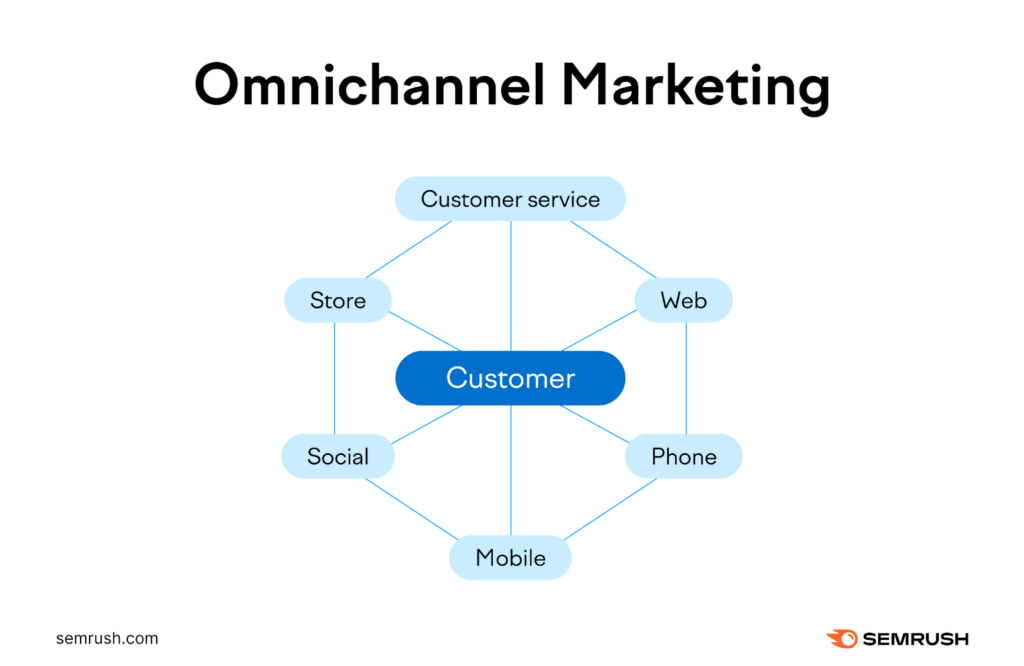
Of course, you can go without omnichannel marketing, but you won’t be able to offer a true personalized experience to Gen Z (in a way they expect it).
It’s not that they just need personal recommendations in their inbox or retargeted ads. They want much more than that.
Read this guide on omnichannel marketing to get started.
Follow these tips to offer personalized content and marketing collateral to Gen Z:
- Use the right tools and apps and make sure all the apps in your martech stack are well-integrated and work collectively as a single unit
- Collect user data and use it to offer personalization
- Leverage dynamic content
- Use segmentation and tags to group customers based on different variables
- Invest in marketing automation and AI.
Final Thoughts
Your brand and its marketing strategy should be flexible and adaptable when marketing to Gen Z.
It’s important to understand that you are dealing with a generation that moves with the pace of digital changes and tech updates. Your business and your marketing strategy must move and change at the same speed.
You can’t stick with one social media platform or one content format to market to Gen Z. You need to constantly tweak your strategy and figure out what’s new in the market and how Zoomers are responding to those changes.
Featured Image: Unsplash



